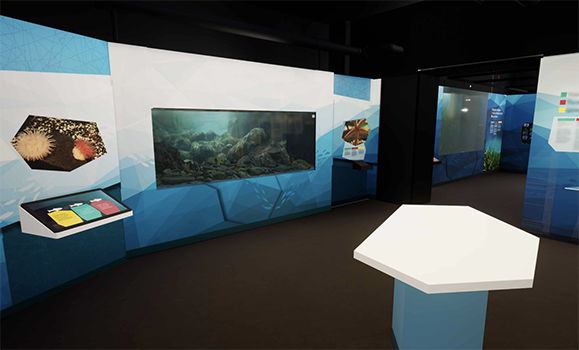How do you make a deep-sea octopus feel at home in a tank? That‚Äôs the question that Nayla Sernowsky (BSc‚Äô24), an aquarist at Ň∑Ī¶ŐŚ”ż‚Äôs Aquatron Laboratory, is trying to answer.
‚ÄúWe've been exploring what kind of enrichment and hiding places we need to add to the tank to make the octopus happy and figuring out her diet,‚ÄĚ Sernowsky says.
‚ÄúWe‚Äôve noticed that when she is not in the mood to eat, she will hide somewhere we can‚Äôt find her, and she‚Äôll probably be completely white. Whereas on days when she‚Äôs showing a lot more activity and interacting with us, she‚Äôs much more of a bright yellow or orange. Those are the signs we use to know she‚Äôs doing well.‚ÄĚ
The octopus is one of several creatures that Sernowsky and her Aquatron colleagues have been collecting from the waters around Nova Scotia since summer 2024. She says the insights the team is gathering on these creatures’ habitats and diets will be invaluable in helping them adjust when they make the move to more permanent digs at the Beaty Centre for Marine Biodiversity.

Scheduled to open in late 2025, the first-of-its-kind interactive ocean and science centre will showcase both the diversity of marine life in the region and related research at Ň∑Ī¶ŐŚ”ż.Őż
‚ÄúWe've specifically chosen to source species locally because we want to highlight the biodiversity that we have here in Nova Scotia,‚ÄĚ Sernowsky explains. ‚ÄúWe‚Äôve also focused on species that would do well in an aquarium environment and showcasing particular habitats ranging from shallow coastal waters all the way to the deep ocean.‚ÄĚ
Distinct habitats, unique creatures
Őż
Sernowsky says there will be seven unique habitat-based exhibits in the centre‚Äôs aquaria. Each exhibit will have a computer tablet that tells the story of the species living there, what they eat, and why they play an important role in that ecosystem. Some of the species are native to the province‚Äôs waters and may be familiar to visitors. They include sea stars, sea cucumbers, pipe fish, and sea ravens ‚ÄĒ the most recent addition to the Aquatron. These large, bottom-dwelling fish have hard, spiky exteriors and change colour based on their environment. They are also ambush predators, which means Sernowsky and her colleagues have had to be creative in their approach to feeding time.Őż
‚ÄúWe found that when we dropped food into the tank, they didn‚Äôt want to eat it,‚ÄĚ Sernowsky says. ‚ÄúWe created a feeding system where we attach food to a long stick with a target and then wave it in front of them so that they come out of their hiding spot to hunt for it. There‚Äôs a lot of trial and error in figuring out how to accommodate different species.‚ÄĚ
Sernowsky says that the lab has also been gathering invasive marine species that will be part of the Beaty Centre exhibits. They include burrowing anemones and green crabs, which destroy the eelgrass beds that sustain local fish, invertebrates, and waterfowl.Őż
‚ÄúThese crabs can outperform native species like rock crabs,‚ÄĚ Sernowsky says. ‚ÄúThey also have impacts on the shellfish industry.‚ÄĚ
A growing collection that aims to inspire
Őż
Sernowsky estimates that she and her Aquatron colleagues have collected approximately one-quarter of the species that will be featured at the Beaty Centre. She says permits are required for each species they catch, and each one is caught by divers ‚ÄĒ a time-consuming effort that poses several challenges.ŐżŐż
‚ÄúFor the last two or three months, we have not been collecting because the water is too cold,‚ÄĚ Sernowsky says. ‚ÄúBut there is always the question of whether we can find them in the wild.‚ÄĚ
Sernowsky expects collection efforts will ramp up in the coming months. She anticipates that they will add species such as coral, which will help create a more natural environment for the octopus, and lumpfish, which have a box-like shape and large eyes. She believes the behaviours and habitats of these species will be just as interesting for the public when the Beaty Centre opens as they are for her.
‚ÄúWe hope it will inspire people of all ages to learn about the marine biology, conservation, and the importance of protecting our oceans,‚ÄĚ she says. ‚ÄúAnd maybe it will encourage younger visitors to consider careers in marine science.‚ÄĚ

